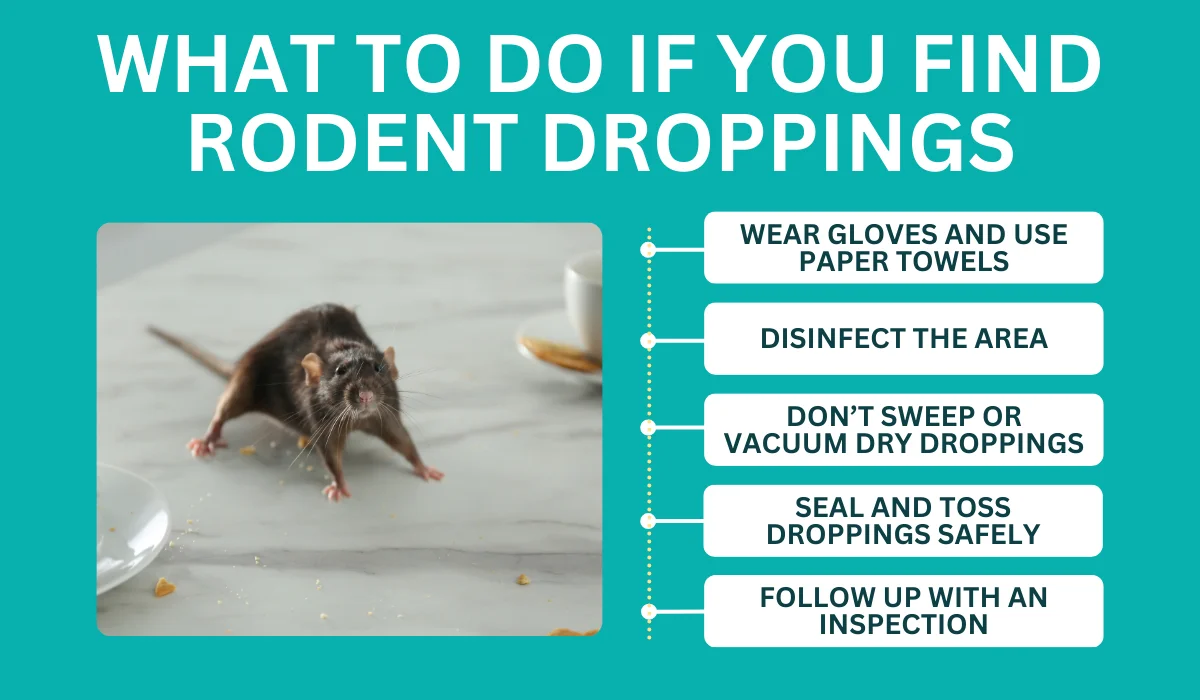Mouse Droppings vs. Rat Droppings: What's the Difference?
If you’ve found rodent droppings around your home—whether it’s in your attic, basement, or pantry—it’s natural to want answers fast. Are you dealing with a mouse infestation, or is a rat problem brewing? And does it even matter?
Spoiler alert: it does.
In this guide, we’ll show you how to tell the difference between mouse poop and rat poop, why it matters, and what to do if you find rodent droppings in your home.
Key Takeaways
- Mouse droppings are small and pointed, while rat droppings are larger with either blunt or pointed ends.
- Rat droppings carry more health risks than mouse poop and usually point to a larger and more serious infestation.
- Cleaning rodent droppings safely means wearing gloves, using disinfectant, and never sweeping or vacuuming dry droppings.
- Rodent droppings in multiple spots mean it’s time to call in the pros and stop the infestation from spreading.
Mouse Droppings vs. Rat Droppings: Key Differences
Before we get into the finer details, let’s break down the basics with a side-by-side comparison:
Features | Mouse Droppings | Rat Droppings |
Size | About the size of a grain of rice | Larger – ½ to ¾ inch long |
Shape | Thin with pointed ends | Blunt ends (Norway rats) or pointed ends (roof rats) |
Color | Dark brown to black | Dark brown to black |
Texture | Dry, solid | Dry, often moist if fresh |
Common Locations | Pantries, baseboards, and behind appliances | Attics, basements, and crawl spaces |
Type of Rodent | House mouse |
Why It Matters to Know the Difference
Now that you can tell mouse droppings from rat droppings, here’s why it’s more than just trivia.
Different Health Risks
Both types of rodent droppings can pose health risks, but rat feces are more commonly linked with hantavirus and leptospirosis. These can become airborne when dried droppings are disturbed.
Varying Rodent Infestation Sizes
A mouse infestation often means there’s a family of mice nesting in walls or behind appliances.
A rat infestation may involve fewer individuals, but rats are larger and more destructive—especially if you're dealing with Norway rats or roof rats.
Different Entry Points
Mice squeeze through holes the size of a dime.
Rats need a bit more space—but roof rats can scale walls and enter through the roof, while Norway rats dig under foundations. Knowing this helps when sealing entry points.
Trapping and Control Methods Differ
Mouse traps won’t work on rats—they’re just too small. And rat baits need to be placed strategically to avoid harming pets. If you're DIY-ing, this distinction really matters.
Pest Control Strategy Changes
Pest control services can handle both mouse and rat problems, but the treatment plans are very different.
Knowing what type of rodent you're dealing with helps tailor the solution, whether it's sealing up crawl spaces or placing rat traps in attics.
What to Do If You Find Rodent Droppings

Spotting rodent droppings in your home isn’t the end of the world, but it is something you want to address quickly and carefully.
Here's how to handle cleanup and your next steps the right way.
1. Wear Gloves and Use Paper Towels
Before touching anything, grab a pair of disposable gloves. Rodent droppings can carry harmful bacteria and viruses, so direct contact is a risk you don’t want to take.
Instead of picking up droppings with your hands or a broom, use paper towels so you can throw everything away immediately after use.
2. Disinfect the Area
Once you’ve picked up the droppings, you’ll need to disinfect the area. A simple bleach solution—one part bleach to ten parts water—works well, or you can use any store-bought disinfectant.
Spray the contaminated area thoroughly and let it soak for at least five minutes. This helps kill any lingering pathogens before you wipe it clean.
3. Don’t Sweep or Vacuum Dry Droppings
It might be tempting to grab the broom or vacuum, especially if you’re in a hurry. But that can actually make things worse.
When rodent droppings dry out, they can break apart into dust.
Sweeping or vacuuming stirs those particles into the air, which puts you at risk of inhaling them. Stick to wet cleaning methods only.
4. Seal and Toss Droppings Safely
After cleanup, make sure you seal the waste properly. Place the droppings, used gloves, and paper towels into a plastic bag.
Seal it tightly before tossing it into your outside trash bin. This keeps germs contained and prevents the smell from spreading indoors.
5. Follow Up With an Inspection
Cleaning up the droppings is only part of the solution.
If you’re seeing signs of rodent activity in more than one area, it’s worth taking a closer look at your home to figure out where the pests are coming from and how they’re getting inside.
Entry points can be as small as a quarter-inch for mice, and rats often use roof vents or gaps in crawl spaces.
Don’t Guess. Know.
It’s easy to mistake one rodent’s droppings for another’s.
Now that you know how to tell the difference between mouse and rat droppings, you’re one step closer to a cleaner, safer home.
If you’re dealing with droppings in multiple areas, that’s a sign of a serious rodent problem. And if you’ve got pet food, bird seed, or other easy food sources lying around, it’s only going to get worse.
At Native Pest Management, we specialize in rodent control in South Florida. Whether it’s house mice, Norway rats, or roof rats, we’ll help you get rid of them—and make sure they don’t come back.
Need help identifying rodent activity in your home? Contact us today.
